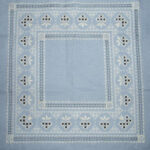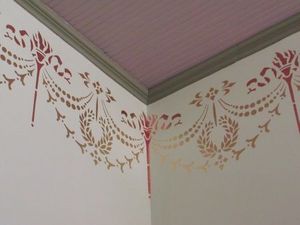To get the best results for appliqué work, choose natural lightweight or medium weight fabrics that are easy to handle. Be sure that all the fabrics are of the same type if they are to be laundered.
Ideas for appliqué designs abound, in magazines, design publications, collections of stencil shapes and in coloring art and needlework books.
To transfer designs, cut a cardboard pattern in the shape of each appliqué piece and trace the shape onto the appliqué surface. Add a 3mm seam allowance for hand sewing and 6mm for machine sewing. Layer the shapes so that you work from background to foreground. Shapes that do not stand by themselves should be positioned to overlap slightly.
Hand-sewing appliqués
Fold and finger-press the seam allowance along the traced outline, to the reverse side and tack the folded edge as you go. Keep the tacking within the seam allowance width.
Pin the appliqué to the background and hold in place with vertical tacking stitches. Secure the appliqué with fine slip-stitching along the folded edges. Remove all tacking. Alternatively use embroidery stitches such as running stitch or cross stitch but remember that these are decorative stitches meant to be seen and so will be part of the design.
Machine-sewing appliqués
Staystich just outside the inner seam-line on the appliqué. Trim the excess margin by cutting along the outer marked line. Fold the seam allowance to the reserve side and tack in place.
Position and pin the appliqué to the backing material, tacking with vertical stitches will keep the appliqué from shifting as you work.
To attach it by the straight-stitch method, set the sewing machine to medium stitch length, then carefully stitch along the folded edge of the appliqué. Pull thread ends through to the reverse side and knot them. Remove all tacking threads and pins.
To attach the appliqué by the zigzag method, position the appliqué and straight-stitch directly over the marked seamline. Trim away the seam allowance as close to the stitching line as possible. Select a suitable width and length for the zigzag and sew over the raw edges and the straight stitch.
Pull the thread ends to the reverse side and knot them. Remove tacking.
Securing appliqués by fusing
A fusing web which is a bonding agent that holds two fabrics together when melted between them is used for this method.
Pin the fusing web to the reverse side of the appliqué material before marking and cutting out the shape, making sure the head of the pin is on the front of the shape. Pin the appliqué and web to the background material with two pins about 5mm (2 inches) apart. Press the tip of a warm iron between the pins to heat fix the appliqué, then remove the pins, place a damp cloth over the appliqué and hold the iron on it until the area is dry.



